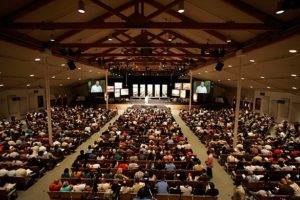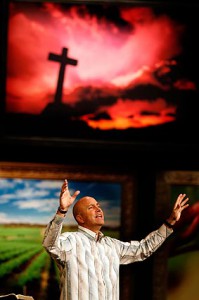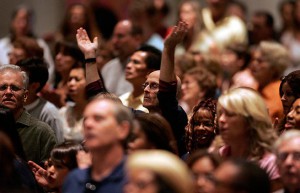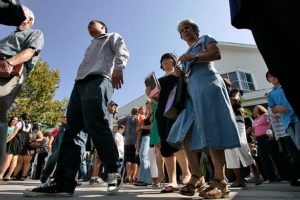Shepherd featured in LA Times article
October 12, 2009
Share This Post:
Once again, the Sunday faithful have packed the cavernous sanctuary at Shepherd of the Hills Church in the San Fernando Valley, clapping and swaying for Jesus as a band rocks the hall.
“Come bless the Lord,” the worshipers sing. “Praise his name to the ends of the Earth.”
Most churches would be thrilled to fill their sanctuaries any day of the year.
Shepherd of the Hills, a nondenominational church in Porter Ranch, does it six times a weekend, attracting 8,000 people to its energetic services and offering a lesson about the growth of evangelical Christianity in California.
Thanks to good weather, sprawling suburbs and a number of charismatic pastors, the Golden State has more of these megachurches — defined as those with at least 2,000 congregants — than any other state. California is home to 193, slightly more than Texas with 191, according to the most recent survey by the Hartford Institute for Religion Research, one of the nation’s leading authorities on megachurches.
The majority of these congregations are in the suburbs between Los Angeles and San Diego, an area that some who study the phenomenon call the Southern California Bible Belt.
A handful have risen to national prominence — notably Saddleback Church in Lake Forest and its celebrity pastor, the Rev. Rick Warren.
But dozens of other large, if lesser-known, churches also are growing, even as many traditional houses of worship struggle to fill their pews.
The megachurches are expanding by adapting to changing times and tastes, scholars say. Many have jettisoned formal rituals such as organs and hymns in favor of Christian rock music and overhead projection screens that display lyrics and prayers.
They deliver upbeat biblical messages about applying faith in everyday life and building a personal relationship with God. They organize parishioners into small “life” groups that study Scripture. And they encourage their followers to recruit new members.
Although some critics refer to the megachurch phenomenon as “church lite,” evangelical Christian scholars say the congregations are reaching the unaffiliated or disaffected by turning church attendance into a more comfortable, positive experience, bound by fewer rules or obligations than traditional churches.
“They want to reach people . . . with the life-changing good news about Jesus Christ,” said Warren Bird, research director of the Dallas-based Leadership Network, a nonprofit that disseminates information about innovative church practices.
Southern California’s sprawling suburban housing tracts have provided ready supplies of potential new members — including Geraldine Victoria, who was raised Catholic but decided to visit Shepherd of the Hills on a recent Sunday at a friend’s invitation.
The 32-year-old Glendale nurse said she was attracted to the spontaneity of the worship service, a departure from what she called the formality of Catholicism. “I think I want more,” Victoria said as she emerged from the sanctuary.
Shepherd of the Hills is rapidly outgrowing its home at the foot of the Santa Susana Mountains, in the northwestern San Fernando Valley. Its gym doubles as a second sanctuary, and church leaders have plans for a 3,500-seat auditorium. It also has opened satellite church campuses in Agua Dulce, Lancaster, Woodland Hills, the Westside and Fremont, near San Jose.
“We’re bursting at the seams,” said senior pastor Dudley C. Rutherford, one of 29 ministers on staff. “We’re not big on ritual and form. We’re big on touching your heart and letting the word of God speak to you.”
The number of megachurches has grown steadily for the last four decades. Researchers say there are now at least 1,350 such churches nationwide, more than double the number a decade ago.
They draw an average of 4,100 weekend parishioners. By contrast, most U.S. churches attract 500 people or fewer on Sundays.
“They are essentially re- creating a small-town milieu and giving folks . . . a place to plug in and share experiences with like-minded people,” said sociologist Scott Thumma of the Hartford Institute for Religion Research in Connecticut, who studies the megachurch movement.
But the growth also has sparked criticism that large churches are siphoning people away from smaller congregations.
Megan Rief, for one, left her Lutheran church in La Verne for Christ’s Church of the Valley in San Dimas, which attracts about 4,500 people to its large worship center each weekend.
The 25-year-old bank teller said the formalities of her former church — including the robed clergy, hymnals, organ and repetitive liturgy — left her uninspired.
At the San Dimas church, she found what she called a fresh approach to her Christian faith that emphasizes a joyful, free-flowing worship and the importance of maintaining a relationship with Jesus seven days a week rather than only on Sundays.
At church, she also met fellow Lutherans, along with Presbyterians and Methodists, all searching for new ways to express their spirituality.
“I’ve become a lot more comfortable in my faith and willing to share that with people,” said Rief, who now volunteers at the church Thursday nights, greeting college students who are treated to dinner and lively worship services.
One recent night, she welcomed visitors for a chicken dinner and then joined them for the service that looked and sounded like a rock concert — with a band, dimmed lights and lyrics about Jesus projected on overhead screens.
Southern California has long been a laboratory of church innovation.
The Rev. Robert H. Schuller, one of the most influential American pastors of the last half-century, preached from the roof of an Orange County drive-in theater snack bar in 1955, and later launched his “Hour of Power” television ministry and built the Crystal Cathedral in Garden Grove.
In 1965, Pastor Chuck Smith opened Calvary Chapel in Costa Mesa, a tiny nondenominational congregation that welcomed hippies and changed the way many American Christians worship by combining literalist Bible teaching with contemporary rock music and casual dress (Smith is fond of Hawaiian shirts).
The worship style helped Smith expand his single church into an empire of 1,500 independent congregations nationwide.
He said several thousand people attend services each weekend at his sprawling Orange County home church, which has 25 pastors, a school and a radio ministry.
“I believe there is a great spiritual hunger,” said Smith, 82, who still preaches weekly. “Jesus said, ‘If any man thirsts, then come to me and drink.’ “
About 85 miles to the south, a newer congregation has demonstrated a deft marketing hand of its own, drawing large numbers through its doors by appealing to niche interests.
San Diego’s Rock Church offers a multitude of ministries, including those for dog lovers, rock climbers, skateboarders, four-wheel-drive enthusiasts, people with eating disorders, even strippers and mimes.
Since it opened in 2000, the church has more than tripled in size. Each weekend, 12,500 adults and children pray in its sanctuary.
Members also are encouraged to put their faith to use in the world outside of the church, which has set a goal this year for its members to perform 600,000 “Do Something” hours of service in San Diego County and beyond — mentoring children, picking up trash, planting trees.
“In the end, God calls us to grow,” said Pastor Miles McPherson, a former San Diego Chargers football player who heads the church.
“It’s not a gimmick. It’s not a technique of a man. It’s got to be the Lord doing it.”





